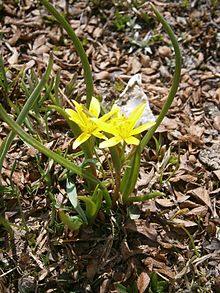Tubular yellow star
| Tubular yellow star | ||||||||||||
|---|---|---|---|---|---|---|---|---|---|---|---|---|

Tubular yellow star ( Gagea fragifera ) |
||||||||||||
| Systematics | ||||||||||||
|
||||||||||||
| Scientific name | ||||||||||||
| Gagea fragifera | ||||||||||||
| ( Vill. ) Ehr.Bayer & G.López |
The tubular yellow star ( Gagea fragifera ) is a species of plant that belongs to the genus yellow star ( Gagea ) in the lily family (Liliaceae). It is widespread in Eurasia .
description
Vegetative characteristics
The tubular yellow star is a perennial, herbaceous plant that reaches heights of 10 to 15 centimeters. This geophyte forms two bulbs enclosed by a common skin as persistent organs. The stems are single, upright, glabrous, unbranched and leafy. The mostly two basal leaves are hairy, 2 to 3 mm wide, linear, tubular and almost round in cross section. The two stem leaves are almost opposite, broadly lanceolate, pointed and glabrous.
Generative characteristics
The flowering period extends from March to July. The two bracts are large, leaf-like and pointed. The flower stalks are more or less hairy. There are one to five flowers per inflorescence. The hermaphrodite flowers are star-shaped and threefold. The six yellow bracts of the same shape are elliptical-lanceolate and blunt. The six stamens are about half as long as the flower envelope.
The capsule fruit is thin-walled and triangular.
The number of chromosomes is 2n = approx. 80.
Occurrence
The distribution area of the tubular yellow star extends from Austria and Switzerland , France (including Corsica) and Spain to Bulgaria , Greece , Italy (including Sicily) and Romania , as well as from Turkey via Iran , Iraq , Lebanon and Syria to Israel and from Russia and Kyrgyzstan to China .
In Germany, the Röhrige Gelbstern occurs only in the Allgäu Alps in the Rappenalptal . It thrives at altitudes of 1200 to 2800 meters on moist, nutrient-rich and mostly lime-poor soils on mountain meadows. He likes to appear in societies of the Poion alpinae or Rumicion alpini, also in the Trisetetum flavescentis.
Taxonomy
It was first published in 1787 under the name ( Basionym ) Ornithogalum fragiferum by Dominique Villars . The new combination to Gagea fragifera (Vill.) Ehr.Bayer & G.López was published in 1989 by Ehrentraud Bayer and Ginés Alejandro López González . Other synonyms for Gagea fragifera (Vill.) Ehr.Bayer & G.López are: Gagea fistulosa auct. Ker.-Gawl. , Gagea emarginata Kar. & Kir. , Gagea liotardii Schult. & Schult. f. nom. superfl.
supporting documents
- Gunter Steinbach (Ed.): Alpine flowers (Steinbach's natural guide). Mosaik Verlag GmbH, Munich 1996, ISBN 3-576-10558-1 .
- Gagea fragifera at Tropicos.org. Missouri Botanical Garden, St. Louis, accessed September 16, 2015. (Taxonomy Section)
Individual evidence
- ↑ a b Erich Oberdorfer : Plant-sociological excursion flora for Germany and neighboring areas . With the collaboration of Angelika Schwabe and Theo Müller. 8th, heavily revised and expanded edition. Eugen Ulmer, Stuttgart (Hohenheim) 2001, ISBN 3-8001-3131-5 , pp. 126 .
- ↑ Erhard Dörr, Wolfgang Lippert : Flora of the Allgäu and its surroundings. Volume 1, IHW, Eching 2001, ISBN 3-930167-50-6 , p. 318.
Web links
- Gagea fistulosa auct. Ker.-Gawl .. In: FloraWeb.de.
- Tubular yellow star . In: BiolFlor, the database of biological-ecological characteristics of the flora of Germany.
- Profile and distribution map for Bavaria . In: Botanical Information Hub of Bavaria .
- Gagea fragifera (Vill.) Ehr. Bayer & G. López In: Info Flora , the national data and information center for Swiss flora .
- Thomas Meyer: Data sheet with identification key and photos at Flora-de: Flora von Deutschland (old name of the website: Flowers in Swabia )

